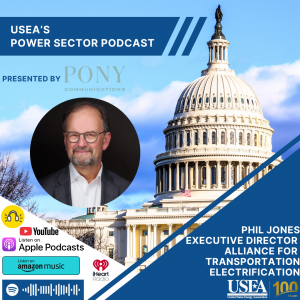October 31st, 2025
In today’s USEA Power Sector Podcast, David Wilson, CEO at software provider Energy Exemplar answered questions by journalist Herman K.
October 28th, 2025
In today’s USEA Power Sector Podcast, James Dobchuk, President and Chief Commercial Officer for Global Laser Enrichment, answered questions by journalist Herman K. Trabish about his company’s just announced break-through in producing low enriched uranium, which can replace supplies currently obtained from Russia and will be urgently needed for the planned nuclear energy industry scale-up.
October 23rd, 2025
In today’s USEA Power Sector Podcast, Edward McGinnis, CEO of next generation nuclear technology startup Curio, answered questions by journalist Herman K. Trabish about how second era nuclear technologies hold the promise of minimizing nuclear power’s traditional water use, spent fuel, and cost challenges to help meet the world’s rapidly growing electricity demand.
October 21st, 2025
In today’s USEA Power Sector Podcast, Ann Collier, Senior Manager, Emerging Technologies with the Smart Electric Power Alliance, answered questions by journalist Herman K. Trabish about the new DELTa database, developed by SEPA and the North Carolina Clean Energy Technology Center, to catalogue and characterize the many quickly emerging rate designs for new large loads like AI data centers.
October 17th, 2025
In today’s USEA Power Sector Podcast, Natural Resources Defense Council Sustainable FERC Project’s Western Markets Advocate Kelsie Gomanie answered questions by journalist Herman K. Trabish about how the passage of California’s Assembly Bill 825 represents a transformative milepost in the coming emergence of Western electricity market regionalization.
October 14th, 2025
In today’s USEA Power Sector Podcast, Shelley Copsey, Co-founder, CEO, and Director of the UK’s FYLD, answered questions by journalist Herman K. Trabish about how AI-driven software services can help electric utilities be more reliable, resilient, and affordable.
October 10th, 2025
In today’s USEA Power Sector Podcast, Amanda Ormond, Director of the Western Grid Group and Principal with the Ormond Group answered questions by journalist Herman K. Trabish about how the passage last Saturday of California’s Assembly Bill 825 represents a transformative milepost in the coming emergence of Western electricity market regionalization.
October 9th, 2025
In today’s USEA Power Sector Podcast, Mike Innocenzo, Chief Operating Officer and Executive Vice President for investor-owned utility giant Exelon answered questions by journalist Herman K. Trabish about how utilities can cope with AI data center-driven load growth and keeping electricity affordable despite the urgent need to invest in power system modernization.
October 6th, 2025
In today’s USEA Power Sector Podcast, SouthWestern Power Group General Manager David Getts answered questions by journalist Herman K. Trabish about the 17-year Homeric odyssey of the SunZia Transmission Project through the U.S. permitting morass and what he learned about how the process can be streamlined.
October 2nd, 2025
In today’s USEA Power Sector Podcast, Phil Jones, Executive Director of the Alliance for Transportation Electrification, answered questions by journalist Herman K. Trabish about the Alliance’s just-released issue brief, “Making Electricity More Affordable with Electric Vehicles,” which found utilities can reduce customer rates with strategies and programs that shift EV charging’s growing electricity demand to off-peak times.
Pages










